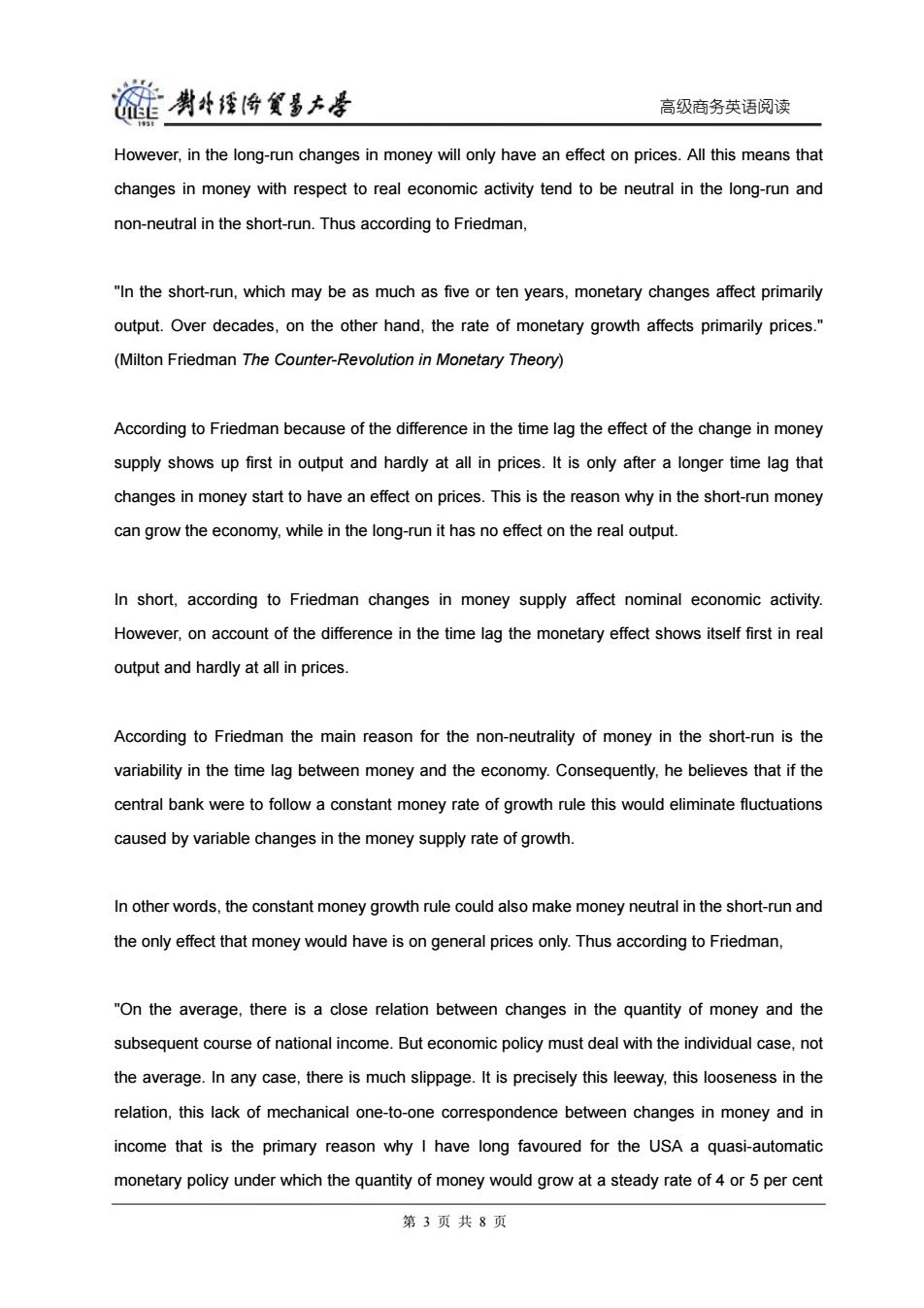正在加载图片...

醛肖经海食多大是 高级商务英语阅读 However,in the long-run changes in money will only have an effect on prices.All this means that changes in money with respect to real economic activity tend to be neutral in the long-run and non-neutral in the short-run.Thus according to Friedman, "In the short-run,which may be as much as five or ten years,monetary changes affect primarily output.Over decades,on the other hand,the rate of monetary growth affects primarily prices." (Milton Friedman The Counter-Revolution in Monetary Theory) According to Friedman because of the difference in the time lag the effect of the change in money supply shows up first in output and hardly at all in prices.It is only after a longer time lag that changes in money start to have an effect on prices.This is the reason why in the short-run money can grow the economy,while in the long-run it has no effect on the real output. In short,according to Friedman changes in money supply affect nominal economic activity. However,on account of the difference in the time lag the monetary effect shows itself first in real output and hardly at all in prices. According to Friedman the main reason for the non-neutrality of money in the short-run is the variability in the time lag between money and the economy.Consequently,he believes that if the central bank were to follow a constant money rate of growth rule this would eliminate fluctuations caused by variable changes in the money supply rate of growth. In other words,the constant money growth rule could also make money neutral in the short-run and the only effect that money would have is on general prices only.Thus according to Friedman, "On the average,there is a close relation between changes in the quantity of money and the subsequent course of national income.But economic policy must deal with the individual case,not the average.In any case,there is much slippage.It is precisely this leeway,this looseness in the relation,this lack of mechanical one-to-one correspondence between changes in money and in income that is the primary reason why I have long favoured for the USA a quasi-automatic monetary policy under which the quantity of money would grow at a steady rate of 4 or 5 per cent 第3页共8页高级商务英语阅读 However, in the long-run changes in money will only have an effect on prices. All this means that changes in money with respect to real economic activity tend to be neutral in the long-run and non-neutral in the short-run. Thus according to Friedman, "In the short-run, which may be as much as five or ten years, monetary changes affect primarily output. Over decades, on the other hand, the rate of monetary growth affects primarily prices." (Milton Friedman The Counter-Revolution in Monetary Theory) According to Friedman because of the difference in the time lag the effect of the change in money supply shows up first in output and hardly at all in prices. It is only after a longer time lag that changes in money start to have an effect on prices. This is the reason why in the short-run money can grow the economy, while in the long-run it has no effect on the real output. In short, according to Friedman changes in money supply affect nominal economic activity. However, on account of the difference in the time lag the monetary effect shows itself first in real output and hardly at all in prices. According to Friedman the main reason for the non-neutrality of money in the short-run is the variability in the time lag between money and the economy. Consequently, he believes that if the central bank were to follow a constant money rate of growth rule this would eliminate fluctuations caused by variable changes in the money supply rate of growth. In other words, the constant money growth rule could also make money neutral in the short-run and the only effect that money would have is on general prices only. Thus according to Friedman, "On the average, there is a close relation between changes in the quantity of money and the subsequent course of national income. But economic policy must deal with the individual case, not the average. In any case, there is much slippage. It is precisely this leeway, this looseness in the relation, this lack of mechanical one-to-one correspondence between changes in money and in income that is the primary reason why I have long favoured for the USA a quasi-automatic monetary policy under which the quantity of money would grow at a steady rate of 4 or 5 per cent 第 3 页 共 8 页